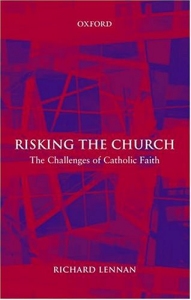
|
Posted January 26, 2005
Book: Risking the Church: The Challenges of Catholic Faith Author: Richard Lennan Oxford University Press, pp. 269 An Excerpt from the Jacket:
An Excerpt from the Book: There are a number of attitudes that members of the church must adopt, and some that they must avoid. First, the prevailing spirit in the church must be other than what Johann Baptist Metz describes as an ‘aggressive backwardness’. Such an attitude, which implies a belief in the supremacy of the past over the present, would convey the impression that members of the church believe their best days to be behind them. ‘Backwardness’ would also suggest a failure to appreciate the church’s eschatological orientation. Whatever its motivation, any approach that divorces the church from the present is unlikely to have widespread appeal in a society that longs for the triumph of hope and a sense of possibility: if the Church becomes the refuge of those who look for security and peace in some world of yesterday, then it should not be astonished when young people turn their back on it and look for the future to uplifting ideologies and redemptive utopias which promise to fill the vacuum which the church’s pusillanimity has left there. Secondly, it is unlikely that the communion of faith would be able to express its identity as a communion dedicated to discipleship of Jesus Christ if it pursues an uncritical adoption of the prevailing social moves. The alternative, to draw again on Metz, is a spirit of ‘creative noncontemporaneity’, which prizes eschatological hope above the comfort that derives from merging seamlessly with the values of any particular moment of history. The communion of faith, therefore, can model authentic human existence, which strives towards transcendence, only if it avoids ‘a merciless confinement within the facticity of the existing order of things’. This means that Christians, while affirming the world as the venue for an encounter with God, will also challenge those aspects of their culture that might obscure either the presence of God or humanity’s orientation to God. Authentic ecclesial faith, then, requires that members of the church maintain the tension between the danger of fossilization and the embrace of values and ways of living that might suggest a denial of human transcendence. The need to maintain that tension suggests that the primary concern of members of the church can never be simply ‘to modernize’ or ‘to up-date’ the church. The challenge, therefore, is less about discerning how to develop a church suited to the ‘modern Catholic,’ a phrase that could imply that we are ‘summing up and going beyond our less advantaged ancestors’, than it is about seeking how to be authentically Catholic in the here and now. In short, the urgent task is the articulation of what is conducive to genuine faith and discipleship in the present, rather than the pursuit of a church that can merge comfortably with what might be currently in vogue, ephemeral though it may be. Thirdly, members of the church must grapple with the fact that ecclesial faith will demand openness to the God who is always greater, the willingness to pursue authenticity, and to prize communion with others, as well as loving service of them. Those demands mean that we understand the church, and our place in it, only when we recognize it as something other than an association whose primary purpose is to provide for the needs of its members. The church then, is not to be a religious consumer of society, where somebody else is always responsible for meeting my needs. It is a participatory communion that depends on the contribution of all. In a society where there is often an obsession with ‘marketing’ and consumer products, an emphasis on the challenge of ecclesial faith can be one expression of ‘creative non-contemporaneity’. Fourthly, healthy ecclesial faith requires openness to the questions that confront faith, both from within the church and beyond it. Such questions promote the need for theology. In the toxic climate of division in the contemporary Catholic church, there can be a suspicion that theology promotes doubt, confusion, and truculent opposition to authority. While it would be disingenuous to claim that it is impossible to co-opt theology for a subversive purpose, theology’s primary purpose is not ideological. Theology manifests the capacity of human beings to wrestle with the mystery of God. In fact, the willingness to address questions — to do theology — expresses the conviction that the members of the church are able to ‘endure education, complexity . . . and the irony that brings an end to innocence but the beginning of wisdom’. There is, then, a need for teachers and pastors within the church ‘to provide an adequate passage towards greater complexity’. Thus, for example, preachers need to encourage engagement between faith and contemporary questions. Conversely, preachers ought not to assume that any member of the church is above, or below, the need for nuance, insight, and deeper understanding of faith. Nor ought they to assume that ‘ordinary people’ do not ask questions: Preachers fail to realize that in their own way, many [‘ordinary people’] are making decisions about theological issues in an unsophisticated and commonsense manner — some staying with the church but with reservations, many others abandoning ship. Often, sad to say, this withdrawal is the result of a naive grasp of the faith — sheer ignorance of what the more sophisticated theological stance of the tradition actually has been and is. Table of Contents: 1. The Church in Peril 2. An undreamed of possibility for love 3. Where the spirit flourishes 4. This church 5. The existing season 6. The overmuch and unfamilar |
|
